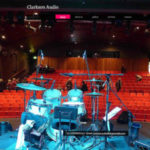Forums › Forums › Qu Forums › Qu feature suggestions › Feature request: Feedback destroyer
- This topic has 28 replies, 2 voices, and was last updated 5 months ago by
neill00.
-
AuthorPosts
-
2019/02/18 at 4:42 am #82040
Mike C
ParticipantI use the delay feature on my Qu outputs & delay my monitors approximately 10-15ms and eliminate feedback problems all the time. Depending on the environment & stage & stage environment, you can accomplish the same thing without feedback programs or units. I make sure there’s no actual delay of any kind to be heard or felt & it works great for me. I’ve also have delayed the outputs as much as 18ms without any problems or delays of the signal only in the right environment. We are all mixing to & balancing our mixes to our acoustic environments.
I have worked with some musicians that could tell something was not right if I started putting up to 15ms of delay on their monitor mix….and they would be letting me know about it.
I have delayed the mains back to the back line a few times and it did help tighten things up a bit.
2019/02/18 at 11:10 am #82049 SteffenRParticipant
SteffenRParticipantdelayed monitors is an absolutly “NO GO”
2019/02/18 at 11:00 pm #82066LeGingy
ParticipantI’ve found 2/3/4ms delay max to be helpful as (for singer) the performer can actually hear whats coming out of the monitors separate to their “head voice”, I end up turning them down with a small delay, it mimics the ms delay you get with analog, but no where near 15 ms…..
2019/02/19 at 1:06 am #82079Mike C
Participantve found 2/3/4ms delay max to be helpful as (for singer) the performer can actually hear whats coming out of the monitors separate to their “head voice”, I end up turning them down with a small delay, it mimics the ms delay you get with analog, but no where near 15 ms…
An all analog mixer path has no latency, well technically it would have some but not even close a full ms, it would be down in the sub nanosecond range.
2019/02/19 at 2:20 pm #82088 SteffenRParticipant
SteffenRParticipantI don’t believe it…
the delay of analog…
and we discuss latency issues2019/02/19 at 2:38 pm #82089Mike C
ParticipantI wonder if the latency through an analog mixer or any analog processor
is really even measurable.For what it’s worth I think the QU spec is 1.2ms from XLR in to XLR out.
2019/02/19 at 2:45 pm #82090 ScottParticipant
ScottParticipantI wonder if the latency through an analog mixer or any analog processor
is really even measurable.Electrical signals travel through analog circuits at the speed of light, so it’s basically irrelevant.
2019/02/19 at 3:36 pm #82094 MarkPAmanParticipant
MarkPAmanParticipantNot quite the speed of light, though it can be quite close. Depends what it’s traveling through.
2019/02/23 at 3:47 am #82167Mark
ParticipantHi Everyone – completely new to forums so please excuse if I don’t follow protocols properly. I have used mixers for many years although my main involvement with sound has been the design and installation of systems. Have just bought a QU16 and feel that the inclusion of some form of automatic feedback suppression would be a definite advantage. While system knowledge and proper training goes a long way towards eliminating most problems, we must remember that in the real world, room acoustics, budget constraints, operator experience, and the time and position constraints involved when using portable systems can all play an overriding part in the end result. Although the QU16 does have variable Q parametrics which are great for notching out the one or two dominant feedback frequencies which sometimes occur, most users of a QU16 size mixer aren’t trained to the degree that they can immediately recognise what those frequencies are. The RTA puts you in the right area but how much easier if the desk just did it for you – or at the very least, gave a readout of what the loudest frequency was. The last three mixers I have installed have been QSC touch-mix’s. While automatic feedback removal was not a primary consideration in their selection, given the skill level of the users, it was a factor.
2023/11/23 at 7:16 pm #116898 funkcityParticipant
funkcityParticipantI have used feedback controllers on 2 mixers.
1 A QSC TouchMix: Completely automatic…(It moves the faders to feedback) You set this up and it finds and kills the offending frequencies. But you can reduce the depth of the notches based on your desired SPL and fidelity desired. When an announcer walked right in front of a speaker it did not feed back! I laughed!
2. A Soundcraft Ui24R (2 DBX feedback killers 1 static and one real-time dynamic “Live”)I set up for a long room to work lengthwise and of course they decided to run the meeting from the side!
I put the Ui in “Live” mode and there was zero feedback or resonances/ringing! and they were very very close to the speakers!
** So given a certain set of circumstances, the Feedback killer is a great tool to have! And the notches are much narrower than your basic parametric or 3rd octave graphic eq.
I really thought A&H would have had it by now?
To note: I also use the Auto-Mix (Dugan-style Gain-sharing) feature for every conference or panel interview. It’s also a must-have too2024/05/29 at 5:28 pm #122453Gary East Street
ParticipantAs a musician who sets up the sound system for our band, I would love a feedback suppression feature, such as the one included in QSC’s TouchMix 16. We own and have used a Touch Mix for a couple of years. Currently, we are evaluating a Qu16. While I love a lot of the characteristics of the Qu, the lack of this feature (along with 2 more DCA’s) is a concern. Yes, I have used a PEQ or GEQ, RTA, pink noise and a reference mic to tune a more permanent location. I’ve and also used the RTA and the GEQ on the QU to find and attenuate problem frequencies at a couple of venues. But, we often have limited setup time and having had the feedback suppression feature on the QSC was a great time saver. Of course, I would also love to be able to place my speakers where I would want them. (And maybe move the walls and ceiling around in a venue 😉), but when you are giging in many locations, you are stuck with what’s there.
2024/05/30 at 9:32 am #122463 Lee7Participant
Lee7ParticipantSorry to say, but the QU is now a 10 year old system and any such features are almost never going to be added. The features that you request can be found in A&H’s latest product, the CQ series.
🙂
2024/08/08 at 12:07 am #124512 funkcityParticipant
funkcityParticipantYes I installed a QU 16 in a church 10 years ago. Its been great but the new CQ looks like the real deal here!
2024/08/15 at 11:53 am #124762neill00
ParticipantCQ looks great but you can still buy the Qu line up. I have the Qu Pac, the closest in the CQ line is the CQ20B and while it has feedback suppression and built in wifi, it has 2 less aux outs and no onboard touch screen mixing. Sure Qu is getting a little long in the tooth but it’s still a viable product and could benefit from feedback suppression. Ya I read all the comments “I can fix feedback by speaker placement and EQ” etc etc., good for you so can I when I have the time which I never do. I play in a 4 piece band we show up 1.5 hours before we start to play. There’s no chance to ring out the room, there are customers there already and there’d be customers there even if I arrived earlier. I do sound from the stage and I’m not getting paid enough to get there early afternoon and make a whole day of it. 99% of the time I don’t have any issues with feedback but it would be nice if A&H had my back when I need them to, especially since they have the tech in the CQ line.
-
AuthorPosts
- You must be logged in to reply to this topic.